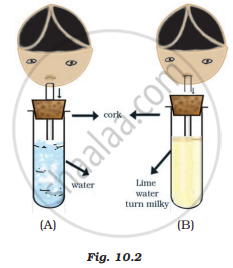Advertisements
Advertisements
प्रश्न
Match the items in Column I with the ones most appropriate in Column II. Rewrite the matching pairs.
|
Column I |
Column II |
|
(a) Alveoli |
(i) where aerobic respiration takes place |
|
(b) Bronchioles |
(ii) lined with hair |
|
(c) Nasal Chamber |
(iii) diffusion of gases |
|
(d) Bronchi |
(iv) small air tubes |
|
(v) an inverted Y shaped tube |
|
|
(vi) a common passage for food and air |
उत्तर
|
Column I |
Column II |
|
(a) Alveoli |
(iii) diffusion of gases |
|
(b) Bronchioles |
(iv) small air tubes |
|
(c) Nasal Chamber |
(ii) lined with hair |
|
(d) Bronchi |
(v) an inverted Y shaped tube |
APPEARS IN
संबंधित प्रश्न
What advantage over an aquatic organism does a terrestrial organism have with regard to obtaining oxygen for respiration?
Compare the functioning of alveoli in the lungs and nephrons in the kidneys with respect to their structure and functioning.
Mention any two components of blood.
Which part of roots is involved in the exchange of respiratory gases?
Out of photosynthesis and respiration in plants, which process occurs:
(a) all the time?
(b) only at daytime?
Name an animal which depends on simple diffusion of gases for breathing.
In the lungs what substance is taken into the body?
State whether the following statement is true or false:
Energy can be produced in cells without oxygen.
State whether the following statement is true or false:
Fish and earthworm exchange gases during respiration in the same way.
Fill in the following blank with suitable word:
Gills are the breathing organs in ___________.
Name the type of respiration in which the end product is:
C2H5OH and CO2
Give one example where such a respiration can occur.
Explain why, it is dangerous to inhale air containing carbon monoxide.
Draw a labelled diagram of the human respiratory system.
Explain how, the air we breathe in gets cleaned while passing through the nasal passage.
Lack of oxygen in muscles often leads to cramps in the legs of sprinters. This is due to the conversion of pyruvate to:
Veins and arteries carry blood. Which of these carry blood away from the heart?
Answer the following in detail.
Explain the process of Cellular Respiration.
Choose the odd one out in the following groups of four items each:
Trachea, Ciliated epithelium, Mucous, Diffusion
Choose the odd one out in each of the following groups of four items each:
Oxyhaemoglobin, Carbaminohaemoglobin, Hypoxia, Carboxyhaemoglobin
State one function of the following:
Mitochondria
How is the respiratory passage kept free of dust particles?
Answer the following question.
How is O2 and CO2 transported in human beings?
Air that enters through the nose passes into this tube.
____________ refers to a biochemical process of oxidation of organic compounds in an orderly manner for the liberation of chemical energy in the form of ATP.
Lack of oxygen in muscles often leads to cramps among cricketers. This results due to:
During respiration exchange of gases take place in
Explain the three pathways of breakdown in living organisms.
Breathing is a process that
- provides O2 to the body.
- breaks down food to release energy.
- helps the body to get rid of CO2.
- produces water in the cells.
Which of the following gives the correct combination of functions of breathing?
Observe Figure 10.2 carefully and answer the following questions.

- Which process is being tested in the activity?
- What is the result of the activity? Give reasons.
